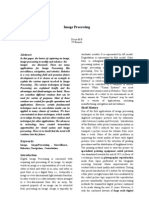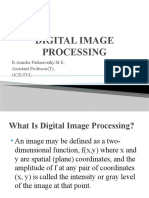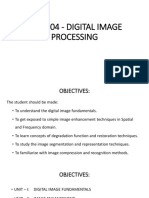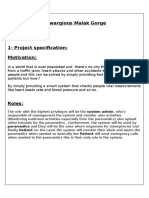0 - Image Processing
Uploaded by
Soham Chakraborty0 - Image Processing
Uploaded by
Soham Chakraborty1
Dept. of CSE
DIGITAL IMAGE FUNDAMENTALS & IMAGE TRANSFORMS
DIGITAL IMAGE FUNDAMENTALS:
The field of digital image processing refers to processing digital images by means of
digital computer. Digital image is composed of a finite number of elements, each of which
has a particular location and value. These elements are called picture elements, image
elements, pels and pixels. Pixel is the term used most widely to denote the elements of
digital image.
An image is a two-dimensional function that represents a measure of some
characteristic such as brightness or color of a viewed scene. An image is a projection of a 3-
D scene into a 2D projection plane.
An image may be defined as a two-dimensional function f(x,y), where x and y are
spatial (plane) coordinates, and the amplitude of f at any pair of coordinates (x,y) is called
the intensity of the image at that point.
The term gray level is used often to refer to the intensity of monochrome images.
Color images are formed by a combination of individual 2-D images.
For example: The RGB color system, a color image consists of three (red, green and
blue) individual component images. For this reason many of the techniques developed for
monochrome images can be extended to color images by processing the three component
images individually.
An image may be continuous with respect to the x- and y- coordinates and also in
amplitude. Converting such an image to digital form requires that the coordinates, as well as
the amplitude, be digitized.
APPLICATIONS OF DIGITAL IMAGE PROCESSING
Since digital image processing has very wide applications and almost all of the technical
fields are impacted by DIP, we will just discuss some of the major applications of DIP.
PEC- IT601D Digital Image Processing
2
Dept. of CSE
Digital image processing has a broad spectrum of applications, such as
• Remote sensing via satellites and other spacecrafts
• Image transmission and storage for business applications
• Medical processing,
• RADAR (Radio Detection and Ranging)
• SONAR(Sound Navigation and Ranging) and
• Acoustic image processing (The study of underwater sound is known as underwater
acoustics or hydro acoustics.)
• Robotics and automated inspection of industrial parts.
Images acquired by satellites are useful in tracking of
• Earth resources;
• Geographical mapping;
• Prediction of agricultural crops,
• Urban growth and weather monitoring
• Flood and fire control and many other environmental applications.
Space image applications include:
• Recognition and analysis of objects contained in images obtained from deep
space-probe missions.
• Image transmission and storage applications occur in broadcast television
• Teleconferencing
• Transmission of facsimile images (Printed documents and graphics) for office
automation
Communication over computer networks
• Closed-circuit television-based security monitoring systems and
• In military communications.
Medical applications:
• Processing of chest X- rays
• Cineangiograms
• Projection images of transaxial tomography and
• Medical images that occur in radiology nuclear magnetic resonance(NMR)
• Ultrasonic scanning
IMAGE PROCESSING TOOLBOX (IPT) is a collection of functions that extend the
capability of the MATLAB numeric computing environment. These functions, and the
PEC- IT601D Digital Image Processing
3
Dept. of CSE
expressiveness of the MATLAB language, make many image-processing operations easy to
write in a compact, clear manner, thus providing a ideal software prototyping environment
for the solution of image processing problem.
Components of Image processing System:
Figure : Components of Image processing System
Image Sensors: With reference to sensing, two elements are required to acquire digital
image. The first is a physical device that is sensitive to the energy radiated by the object we
wish to image and second is specialized image processing hardware.
Specialize image processing hardware: It consists of the digitizer just mentioned, plus
hardware that performs other primitive operations such as an arithmetic logic unit, which
performs arithmetic such addition and subtraction and logical operations in parallel on images.
Computer: It is a general purpose computer and can range from a PC to a supercomputer
depending on the application. In dedicated applications, sometimes specially designed
computer are used to achieve a required level of performance
Software: It consists of specialized modules that perform specific tasks a well designed
package also includes capability for the user to write code, as a minimum, utilizes the
specialized module. More sophisticated software packages allow the integration of these
modules.
PEC- IT601D Digital Image Processing
4
Dept. of CSE
Mass storage: This capability is a must in image processing applications. An image of size
1024 x1024 pixels, in which the intensity of each pixel is an 8- bit quantity requires one
Megabytes of storage space if the image is not compressed. I m a g e processing
applicationsfalls into three principal categories of storage
i) Short term storage for use during processing
ii) On line storage for relatively fast retrieval
iii) Archival storage such as magnetic tapes and disks
Image display: Image displays in use today are mainly color TV monitors. These monitors
are driven by the outputs of image and graphics displays cards that are an integral part of
computer system.
Hardcopy devices: The devices for recording image includes laser printers, film cameras,
heat sensitive devices inkjet units and digital units such as optical and CD ROM disk. Films
provide the highest possible resolution, but paper is the obvious medium of choice for written
applications.
Networking: It is almost a default function in any computer system in use today because of
the large amount of data inherent in image processing applications. The key consideration in
image transmission bandwidth.
Fundamental Steps in Digital Image Processing:
There are two categories of the steps involved in the image processing –
1. Methods whose outputs are input are images.
2. Methods whose outputs are attributes extracted from those images.
Fig: Fundamental Steps in Digital Image Processing
PEC- IT601D Digital Image Processing
5
Dept. of CSE
Image acquisition: It could be as simple as being given an image that is already in digital
form. Generally, the image acquisition stage involves processing such scaling.
Image Enhancement: It is among the simplest and most appealing areas of digital image
processing. The idea behind this is to bring out details that are obscured or simply to
highlight certain features of interest in image. Image enhancement is a very subjective area of
image processing.
Image Restoration: It deals with improving the appearance of an image. It is an objective
approach, in the sense that restoration techniques tend to be based on mathematical or
probabilistic models of image processing. Enhancement, on the other hand is based on human
subjective preferences regarding what constitutes a “good” enhancement result.
Color image processing: It is an area that is been gaining importance because of the use of
digital images over the internet. Color image processing deals with basically color models
and their implementation in image processing applications.
Wavelets and Multiresolution Processing: These are the foundation for representing image
in various degrees of resolution.
Compression: It deals with techniques reducing the storage required to save an image, or the
bandwidth required to transmit it over the network. It has to major approaches a) Lossless
Compression b) Lossy Compression
Morphological processing: It deals with tools for extracting image components that are
useful in the representation and description of shape and boundary of objects. It is majorly
used in automated inspection applications.
PEC- IT601D Digital Image Processing
6
Dept. of CSE
Representation and Description: It always follows the output of segmentation step that is,
raw pixel data, constituting either the boundary of an image or points in the region itself. In
either case converting the data to a form suitable for computer processing is necessary.
Recognition: It is the process that assigns label to an object based on its descriptors. It is the
last step of image processing which use artificial intelligence of software.
Knowledge base:
Knowledge about a problem domain is coded into an image processing system in the form of
a knowledge base. This knowledge may be as simple as detailing regions of an image where
the information of the interest in known to be located. Thus limiting search that has to be
conducted in seeking the information. The knowledge base also can be quite complex such
interrelated list of all major possible defects in a materials inspection problems or an image
database containing high resolution satellite images of a region in connection with change
detection application.
A Simple Image Model:
An image is denoted by a two dimensional function of the form f{x, y}. The value or
amplitude of f at spatial coordinates {x,y} is a positive scalar quantity whose physical
meaning is determined by the source of the image. When an image is generated by a physical
process, its values are proportional to energy radiated by a physical source. As a
consequence, f(x,y) must be nonzero and finite; that is o<f(x,y) <co The function f(x,y) may
be characterized by two components- The amount of the source illumination incident on the
scene being viewed.
(a) The amount of the source illumination reflected back by the objects in the scene
These are called illumination and reflectance components and are denoted by i(x,y) an r (x,y)
respectively.
The functions combine as a product to form f(x,y). We call the intensity of a monochrome
image at any coordinates (x,y) the gray level (l) of the image at that point l= f (x, y.)
L min ≤ l ≤ Lmax
Lmin is to be positive and Lmax must be finite
Lmin = imin rmin
Lmax = imax rmax
The interval [Lmin, Lmax] is called gray scale. Common practice is to shift this interval
numerically to the interval [0, L-l] where l=0 is considered black and l= L-1 is considered
PEC- IT601D Digital Image Processing
7
Dept. of CSE
white on the gray scale. All intermediate values are shades of gray of gray varying from
black to white.
SAMPLING AND QUANTIZATION:
To create a digital image, we need to convert the continuous sensed data into digital from.
This involves two processes – sampling and quantization. An image may be continuous with
respect to the x and y coordinates and also in amplitude. To convert it into digital form we
have to sample the function in both coordinates and in amplitudes.
Digitalizing the coordinate values is called sampling. Digitalizing the amplitude values is
called quantization. There is a continuous the image along the line segment AB. To simple
this function, we take equally spaced samples along line AB. The location of each samples is
given by a vertical tick back (mark) in the bottom part. The samples are shown as block
squares superimposed on function the set of these discrete locations gives the sampled
function.
In order to form a digital, the gray level values must also be converted (quantized) into
discrete quantities. So we divide the gray level scale into eight discrete levels ranging from
eight level values. The continuous gray levels are quantized simply by assigning one of the
eight discrete gray levels to each sample. The assignment it made depending on the vertical
proximity of a simple to a vertical tick mark.
Starting at the top of the image and covering out this procedure line by line produces a two
dimensional digital image.
Digital Image definition:
A digital image f(m,n) described in a 2D discrete space is derived from an analog
image f(x,y) in a 2D continuous space through a sampling process that is frequently referred
to as digitization. The mathematics of that sampling process will be described in subsequent
Chapters. For now we will look at some basic definitions associated with the digital image.
The effect of digitization is shown in figure.
The 2D continuous image f(x,y) is divided into N rows and M columns. The
intersection of a row and a column is termed a pixel. The value assigned to the integer
coordinates (m,n) with m=0,1,2..N-1 and n=0,1,2…N-1 is f(m,n). In fact, in most cases, is
actually a function of many variables including depth, color and time (t).
PEC- IT601D Digital Image Processing
8
Dept. of CSE
There are three types of computerized processes in the processing of image
1) Low level process -these involve primitive operations such as image processing to reduce
noise, contrast enhancement and image sharpening. These kind of processes are characterized
by fact the both inputs and output are images.
2) Mid level image processing - it involves tasks like segmentation, description of those
objects to reduce them to a form suitable for computer processing, and classification of
individual objects. The inputs to the process are generally images but outputs are attributes
extracted from images.
3) High level processing – It involves “making sense” of an ensemble of recognized objects,
as in image analysis, and performing the cognitive functions normally associated with vision.
Representing Digital Images:
The result of sampling and quantization is matrix of real numbers. Assume that an
image f(x,y) is sampled so that the resulting digital image has M rows and N Columns. The
values of the coordinates (x,y) now become discrete quantities thus the value of the
coordinates at orgin become 9X,y) =(o,o) The next Coordinates value along the first signify
the iamge along the first row. it does not mean that these are the actual values of physical
coordinates when the image was sampled.
Thus the right side of the matrix represents a digital element, pixel or pel. The matrix can be
represented in the following form as well. The sampling process may be viewed as
partitioning the xy plane into a grid with the coordinates of the center of each grid being a
pair of elements from the Cartesian products Z2 which is the set of all ordered pair of
elements (Zi, Zj) with Zi and Zj being integers from Z. Hence f(x,y) is a digital image if gray
PEC- IT601D Digital Image Processing
9
Dept. of CSE
level (that is, a real number from the set of real number R) to each distinct pair of coordinates
(x,y). This functional assignment is the quantization process. If the gray levels are also
integers, Z replaces R, the and a digital image become a 2D function whose coordinates and
she amplitude value are integers. Due to processing storage and hardware consideration, the
number gray levels typically is an integer power of 2.
k
L=2
Then, the number, b, of bites required to store a digital image is B=M *N* k When M=N, the
2
equation become b=N *k
When an image can have 2k gray levels, it is referred to as “k- bit”. An image with 256
8
possible gray levels is called an “8- bit image” (256=2 ).
Spatial and Gray level resolution:
Spatial resolution is the smallest discernible details are an image. Suppose a chart can be
constructed with vertical lines of width w with the space between the also having width W,
so a line pair consists of one such line and its adjacent space thus. The width of the line pair
is 2w and there is 1/2w line pair per unit distance resolution is simply the smallest number of
discernible line pair unit distance.
Gray levels resolution refers to smallest discernible change in gray levels. Measuring
discernible change in gray levels is a highly subjective process reducing the number of bits R
while repairing the spatial resolution constant creates the problem of false contouring.
It is caused by the use of an insufficient number of gray levels on the smooth areas of
the digital image. It is called so because the rides resemble top graphics contours in a map. It
is generally quite visible in image displayed using 16 or less uniformly spaced gray levels.
Image sensing and Acquisition:
The types of images in which we are interested are generated by the combination of an
“illumination” source and the reflection or absorption of energy from that source by the
elements of the “scene” being imaged. We enclose illumination and scene in quotes to
emphasize the fact that they are considerably more general than the familiar situation in
which a visible light source illuminates a common everyday 3-D (three-dimensional) scene.
For example, the illumination may originate from a source of electromagnetic energy such as
radar, infrared, or X-ray energy. But, as noted earlier, it could originate from less traditional
sources, such as ultrasound or even a computer-generated illumination pattern. Similarly, the
scene elements could be familiar objects, but they can just as easily be molecules, buried
rock formations, or a human brain. We could even image a source, such as acquiring images
PEC- IT601D Digital Image Processing
10
Dept. of CSE
of the sun. Depending on the nature of the source, illumination energy is reflected from, or
transmitted through, objects. An example in the first category is light reflected from a planar
surface. An example in the second category is when X-rays pass through a patient‟s body for
the purpose of generating a diagnostic X-ray film. In some applications, the reflected or
transmitted energy is focused onto a photo converter (e.g., a phosphor screen), which
converts the energy into visible light. Electron microscopy and some applications of gamma
imaging use this approach. The idea is simple: Incoming energy is transformed into a voltage
by the combination of input electrical power and sensor material that is responsive to the
particular type of energy being detected. The output voltage waveform is the response of the
sensor(s), and a digital quantity is obtained from each sensor by digitizing its response. In
this section, we look at the principal modalities for image sensing and generation.
Fig:Single Image sensor
Fig: Line Sensor
Fig: Array sensor
Image Acquisition using a Single sensor:
The components of a single sensor. Perhaps the most familiar sensor of this type is
the photodiode, which is constructed of silicon materials and whose output voltage waveform
is proportional to light. The use of a filter in front of a sensor improves selectivity. For
PEC- IT601D Digital Image Processing
11
Dept. of CSE
example, a green (pass) filter in front of a light sensor favors light in the green band of the
color spectrum. As a consequence, the sensor output will be stronger for green light than for
other components in the visible spectrum.
In order to generate a 2-D image using a single sensor, there has to be relative displacements
in both the x- and y-directions between the sensor and the area to be imaged. Figure shows an
arrangement used in high-precision scanning, where a film negative is mounted onto a drum
whose mechanical rotation provides displacement in one dimension. The single sensor is
mounted on a lead screw that provides motion in the perpendicular direction. Since
mechanical motion can be controlled with high precision, this method is an inexpensive (but
slow) way to obtain high-resolution images. Other similar mechanical arrangements use a flat
bed, with the sensor moving in two linear directions. These types of mechanical digitizers
sometimes are referred to as microdensitometers.
Image Acquisition using a Sensor strips:
A geometry that is used much more frequently than single sensors consists of an in-line
arrangement of sensors in the form of a sensor strip, shows. The strip provides imaging
elements in one direction. Motion perpendicular to the strip provides imaging in the other
direction. This is the type of arrangement used in most flat bed scanners. Sensing devices
with 4000 or more in-line sensors are possible. In-line sensors are used routinely in airborne
imaging applications, in which the imaging system is mounted on an aircraft that flies at a
constant altitude and speed over the geographical area to be imaged. One dimensional
imaging sensor strips that respond to various bands of the electromagnetic spectrum are
mounted perpendicular to the direction of flight. The imaging strip gives one line of an image
at a time, and the motion of the strip completes the other dimension of a two-dimensional
image. Lenses or other focusing schemes are used to project area to be scanned onto the
sensors. Sensor strips mounted in a ring configuration are used in medical and industrial
imaging to obtain cross-sectional (“slice”) images of 3-D objects.
PEC- IT601D Digital Image Processing
12
Dept. of CSE
Fig: Image Acquisition using linear strip and circular strips.
Image Acquisition using a Sensor Arrays:
The individual sensors arranged in the form of a 2-D array. Numerous electromagnetic and
some ultrasonic sensing devices frequently are arranged in an array format. This is also the
predominant arrangement found in digital cameras. A typical sensor for these cameras is a
CCD array, which can be manufactured with a broad range of sensing properties and can be
packaged in rugged arrays of elements or more. CCD sensors are used widely in digital
cameras and other light sensing instruments. The response of each sensor is proportional to
the integral of the light energy projected onto the surface of the sensor, a property that is used
in astronomical and other applications requiring low noise images. Noise reduction is
achieved by letting the sensor integrate the input light signal over minutes or even hours. The
two dimensional, its key advantage is that a complete image can be obtained by focusing the
energy pattern onto the surface of the array. Motion obviously is not necessary, as is the case
with the sensor arrangements This figure shows the energy from an illumination source being
reflected from a scene element, but, as mentioned at the beginning of this section, the energy
also could be transmitted through the scene elements. The first function performed by the
imaging system is to collect the incoming energy and focus it onto an image plane. If the
illumination is light, the front end of the imaging system is a lens, which projects the viewed
scene onto the lens focal plane. The sensor array, which is coincident with the focal plane,
produces outputs proportional to the integral of the light received at each sensor. Digital and
PEC- IT601D Digital Image Processing
13
Dept. of CSE
analog circuitry sweep these outputs and convert them to a video signal, which is then
digitized by another section of the imaging system.
Image sampling and Quantization:
To create a digital image, we need to convert the continuous sensed data into digital form.
This involves two processes: sampling and quantization. A continuous image, f(x, y), that we
want to convert to digital form. An image may be continuous with respect to the x- and y-
coordinates, and also in amplitude. To convert it to digital form, we have to sample the
function in both coordinates and in amplitude. Digitizing the coordinate values is called
sampling. Digitizing the amplitude values is called quantization.
PEC- IT601D Digital Image Processing
14
Dept. of CSE
Digital Image representation:
Digital image is a finite collection of discrete samples (pixels) of any observable object. The
pixels represent a two- or higher dimensional “view” of the object, each pixel having its own
discrete value in a finite range. The pixel values may represent the amount of visible light,
infra red light, absortation of x-rays, electrons, or any other measurable value such as
ultrasound wave impulses. The image does not need to have any visual sense; it is sufficient
that the samples form a two-dimensional spatial structure that may be illustrated as an image.
The images may be obtained by a digital camera, scanner, electron microscope, ultrasound
stethoscope, or any other optical or non-optical sensor. Examples of digital image are:
• digital photographs
• satellite images
• radiological images (x-rays, mammograms)
• binary images, fax images, engineering drawings
Computer graphics, CAD drawings, and vector graphics in general are not considered in this
course even though their reproduction is a possible source of an image. In fact, one goal of
intermediate level image processing may be to reconstruct a model (e.g. vector
representation) for a given digital image.
RELATIONSHIP BETWEEN PIXELS:
We consider several important relationships between pixels in a digital image.
NEIGHBORS OF A PIXEL
• A pixel p at coordinates (x,y) has four horizontal and vertical neighbors whose
coordinates are given by:
(x+1,y), (x-1, y), (x, y+1), (x,y-1)
This set of pixels, called the 4-neighbors or p, is denoted by N4(p). Each pixel is one
unit distance from (x,y) and some of the neighbors of p lie outside the digital image if (x,y) is
on the border of the image. The four diagonal neighbors of p have coordinates and are
denoted by ND (p).
(x+1, y+1), (x+1, y-1), (x-1, y+1), (x-1, y-1)
PEC- IT601D Digital Image Processing
15
Dept. of CSE
These points, together with the 4-neighbors, are called the 8-neighbors of p, denoted
by N8 (p).
As before, some of the points in ND (p) and N8 (p) fall outside the image if (x,y) is on
the border of the image.
ADJACENCY AND CONNECTIVITY
Let v be the set of gray –level values used to define adjacency, in a binary image, v={1}.
In a gray-scale image, the idea is the same, but V typically contains more elements, for
example, V = {180, 181, 182, …, 200}.
If the possible intensity values 0 – 255, V set can be any subset of these 256 values.
if we are reference to adjacency of pixel with value.
Three types of adjacency
• 4- Adjacency – two pixel P and Q with value from V are 4 –adjacency if A is in the
set N4(P)
• 8- Adjacency – two pixel P and Q with value from V are 8 –adjacency if A is in the
set N8(P)
• M-adjacency –two pixel P and Q with value from V are m – adjacency if (i) Q is in
N4(p) or (ii) Q is in ND(q) and the set N4(p) ∩ N4(q) has no pixel whose values are
from V.
• Mixed adjacency is a modification of 8-adjacency. It is introduced to eliminate the
ambiguities that often arise when 8-adjacency is used.
• For example:
PEC- IT601D Digital Image Processing
16
Dept. of CSE
Fig:1.8(a) Arrangement of pixels; (b) pixels that are 8-adjacent (shown dashed) to the
center pixel; (c) m-adjacency.
Types of Adjacency:
• In this example, we can note that to connect between two pixels (finding a path
between two pixels):
– In 8-adjacency way, you can find multiple paths between two pixels
– While, in m-adjacency, you can find only one path between two pixels
• So, m-adjacency has eliminated the multiple path connection that has been generated
by the 8-adjacency.
• Two subsets S1 and S2 are adjacent, if some pixel in S1 is adjacent to some pixel in S2.
Adjacent means, either 4-, 8- or m-adjacency.
A Digital Path:
• A digital path (or curve) from pixel p with coordinate (x,y) to pixel q with coordinate (s,t)
is a sequence of distinct pixels with coordinates (x0,y0), (x1,y1), …, (xn, yn) where (x0,y0) =
(x,y) and (xn, yn) = (s,t) and pixels (xi, yi) and (xi-1, yi-1) are adjacent for 1 ≤ i ≤ n
• n is the length of the path
• If (x0,y0) = (xn, yn), the path is closed.
We can specify 4-, 8- or m-paths depending on the type of adjacency specified.
• Return to the previous example:
Fig:1.8 (a) Arrangement of pixels; (b) pixels that are 8-adjacent(shown dashed) to the
center pixel; (c) m-adjacency.
In figure (b) the paths between the top right and bottom right pixels are 8-paths. And
the path between the same 2 pixels in figure (c) is m-path
Connectivity:
• Let S represent a subset of pixels in an image, two pixels p and q are said to be
connected in S if there exists a path between them consisting entirely of pixels in S.
PEC- IT601D Digital Image Processing
17
Dept. of CSE
• For any pixel p in S, the set of pixels that are connected to it in S is called a connected
component of S. If it only has one connected component, then set S is called a
connected set.
Region and Boundary:
• REGION: Let R be a subset of pixels in an image, we call R a region of the image if R
is a connected set.
• BOUNDARY: The boundary (also called border or contour) of a region R is
the set of pixels in the region that have one or more neighbors that are not in R.
If R happens to be an entire image, then its boundary is defined as the set of pixels in the first
and last rows and columns in the image. This extra definition is required because an image
has no neighbors beyond its borders. Normally, when we refer to a region, we are referring to
subset of an image, and any pixels in the boundary of the region that happen to coincide with
the border of the image are included implicitly as part of the region boundary.
DISTANCE MEASURES:
For pixel p,q and z with coordinate (x.y) ,(s,t) and (v,w) respectively D is a distance function
or metric if
D [p.q] ≥ O {D[p.q] = O iff p=q}
D [p.q] = D [p.q] and
D [p.q] ≥ O {D[p.q]+D(q,z)
• The Euclidean Distance between p and q is defined as:
De (p,q) = [(x – s)2 + (y - t)2]1/2
Pixels having a distance less than or equal to some value r from (x,y) are the points
contained in a disk of radius „ r „centered at (x,y)
• The D4 distance (also called city-block distance) between p and q is defined as:
D4 (p,q) = | x – s | + | y – t |
PEC- IT601D Digital Image Processing
18
Dept. of CSE
Pixels having a D4 distance from (x,y), less than or equal to some value r form a
Diamond centered at (x,y)
Example:
The pixels with distance D4 ≤ 2 from (x,y) form the following contours of
constant distance.
The pixels with D4 = 1 are the 4-neighbors of (x,y)
• The D8 distance (also called chessboard distance) between p and q is defined as:
D8 (p,q) = max(| x – s |,| y – t |)
Pixels having a D8 distance from (x,y), less than or equal to some value r form a
square Centered at (x,y).
Example:
D8 distance ≤ 2 from (x,y) form the following contours of constant distance.
• Dm distance:
It is defined as the shortest m-path between the points.
PEC- IT601D Digital Image Processing
19
Dept. of CSE
In this case, the distance between two pixels will depend on the values of the
pixels along the path, as well as the values of their neighbors.
• Example:
Consider the following arrangement of pixels and assume that p, p2, and p4
have value 1 and that p1 and p3 can have can have a value of 0 or 1 Suppose
that we consider the adjacency of pixels values 1 (i.e. V = {1})
Now, to compute the Dm between points p and p4
Here we have 4 cases:
Case1: If p1 =0 and p3 = 0
The length of the shortest m-path
(the Dm distance) is 2 (p, p2, p4)
Case2: If p1 =1 and p3 = 0
now, p1 and p will no longer be adjacent (see m-adjacency definition)
then, the length of the shortest
path will be 3 (p, p1, p2, p4)
Case3: If p1 =0 and p3 = 1
The same applies here, and the shortest –m-path will be 3 (p, p2, p3, p4)
PEC- IT601D Digital Image Processing
20
Dept. of CSE
Case4: If p1 =1 and p3 = 1
The length of the shortest m-path will be 4 (p, p1 , p2, p3, p4)
PEC- IT601D Digital Image Processing
You might also like
- 9 Ways BMC Helix Itsm Beats The Competition 2No ratings yet9 Ways BMC Helix Itsm Beats The Competition 213 pages
- Stock Watson 3u Exercise Solutions Chapter 13 InstructorsNo ratings yetStock Watson 3u Exercise Solutions Chapter 13 Instructors15 pages
- 6.digital Image Processing (1) - Pages-DeletedNo ratings yet6.digital Image Processing (1) - Pages-Deleted61 pages
- Digital Image Processing Lecture Notes: M.Sc. Cs - (Iv Sem) (2020-2021)No ratings yetDigital Image Processing Lecture Notes: M.Sc. Cs - (Iv Sem) (2020-2021)28 pages
- 21 AD6703 UNIT I DIGITAL IMAGE FUNDAMENTALS[1]No ratings yet21 AD6703 UNIT I DIGITAL IMAGE FUNDAMENTALS[1]24 pages
- EC8093 Notes KSN - by WWW - Easyengineering.net 4No ratings yetEC8093 Notes KSN - by WWW - Easyengineering.net 4137 pages
- Group 1-Intruduction and Digital Image FundamentalNo ratings yetGroup 1-Intruduction and Digital Image Fundamental35 pages
- Intoduction: Image Processing and Compression TechniquesNo ratings yetIntoduction: Image Processing and Compression Techniques61 pages
- Godavari Institute of Enginnering and Technology: Image ProcessingNo ratings yetGodavari Institute of Enginnering and Technology: Image Processing15 pages
- CSE-IT-312 DIP -2 Definition Steps and ApplicationNo ratings yetCSE-IT-312 DIP -2 Definition Steps and Application84 pages
- Digital Image Processing: Edge Detection System For Noisy ImagesNo ratings yetDigital Image Processing: Edge Detection System For Noisy Images55 pages
- Digital Image Processing: Edge Detection System For Noisy ImagesNo ratings yetDigital Image Processing: Edge Detection System For Noisy Images55 pages
- Computer Vision: Dr. Sukhendu Das Deptt. of Computer Science and Engg., IIT Madras, Chennai - 600036No ratings yetComputer Vision: Dr. Sukhendu Das Deptt. of Computer Science and Engg., IIT Madras, Chennai - 60003621 pages
- Digital Image Processing and Pattern Recognition67% (3)Digital Image Processing and Pattern Recognition10 pages
- Image Processing: By: Prof. Monika ShahNo ratings yetImage Processing: By: Prof. Monika Shah57 pages
- Lung Cancer Detection Using Digital Image Processing67% (3)Lung Cancer Detection Using Digital Image Processing40 pages
- Image Compression: Efficient Techniques for Visual Data OptimizationFrom EverandImage Compression: Efficient Techniques for Visual Data OptimizationNo ratings yet
- The Daughters of The Late Colonel1920 DoneNo ratings yetThe Daughters of The Late Colonel1920 Done17 pages
- An Er Diagram About College Database For OurNo ratings yetAn Er Diagram About College Database For Our13 pages
- Bio-Diversity Uses, Threats and Conservation: Dr. Anjay100% (1)Bio-Diversity Uses, Threats and Conservation: Dr. Anjay23 pages
- Complete Download Doing Business with the Republic of Cyprus Phillip Dew PDF All Chapters100% (3)Complete Download Doing Business with the Republic of Cyprus Phillip Dew PDF All Chapters91 pages
- Beneheart R12: Peripherals and CommunicationsNo ratings yetBeneheart R12: Peripherals and Communications4 pages
- For HDFC ERGO General Insurance Company LTDNo ratings yetFor HDFC ERGO General Insurance Company LTD2 pages
- Instruction Manual: Autoclaves & SterilizersNo ratings yetInstruction Manual: Autoclaves & Sterilizers61 pages
- Ict - Telecom Osp Installation (Fiber Optic Cable) NC Ii PDFNo ratings yetIct - Telecom Osp Installation (Fiber Optic Cable) NC Ii PDF15 pages
- Financial Management Theory and Practice 14th Edition Brigham Test Bank download pdf100% (15)Financial Management Theory and Practice 14th Edition Brigham Test Bank download pdf66 pages
- 4 - 10-21-2022 - 10-26-38 - Bachelor of Arts (First To Sixth Semester)No ratings yet4 - 10-21-2022 - 10-26-38 - Bachelor of Arts (First To Sixth Semester)68 pages
- 7.soru Fren Si̇stem Ve Balata Deği̇şi̇mi̇No ratings yet7.soru Fren Si̇stem Ve Balata Deği̇şi̇mi̇10 pages
- Unit-1 - Technology of Meat, Fish, Poultry & Their ProductsNo ratings yetUnit-1 - Technology of Meat, Fish, Poultry & Their Products11 pages
- Performance-Related and Skill-Based Pay: An Introduction: ACT/EMP/17No ratings yetPerformance-Related and Skill-Based Pay: An Introduction: ACT/EMP/1744 pages
- Stock Watson 3u Exercise Solutions Chapter 13 InstructorsStock Watson 3u Exercise Solutions Chapter 13 Instructors
- Digital Image Processing Lecture Notes: M.Sc. Cs - (Iv Sem) (2020-2021)Digital Image Processing Lecture Notes: M.Sc. Cs - (Iv Sem) (2020-2021)
- Group 1-Intruduction and Digital Image FundamentalGroup 1-Intruduction and Digital Image Fundamental
- Intoduction: Image Processing and Compression TechniquesIntoduction: Image Processing and Compression Techniques
- Godavari Institute of Enginnering and Technology: Image ProcessingGodavari Institute of Enginnering and Technology: Image Processing
- CSE-IT-312 DIP -2 Definition Steps and ApplicationCSE-IT-312 DIP -2 Definition Steps and Application
- Digital Image Processing: Edge Detection System For Noisy ImagesDigital Image Processing: Edge Detection System For Noisy Images
- Digital Image Processing: Edge Detection System For Noisy ImagesDigital Image Processing: Edge Detection System For Noisy Images
- Computer Vision: Dr. Sukhendu Das Deptt. of Computer Science and Engg., IIT Madras, Chennai - 600036Computer Vision: Dr. Sukhendu Das Deptt. of Computer Science and Engg., IIT Madras, Chennai - 600036
- Lung Cancer Detection Using Digital Image ProcessingLung Cancer Detection Using Digital Image Processing
- Image Compression: Efficient Techniques for Visual Data OptimizationFrom EverandImage Compression: Efficient Techniques for Visual Data Optimization
- Bio-Diversity Uses, Threats and Conservation: Dr. AnjayBio-Diversity Uses, Threats and Conservation: Dr. Anjay
- Complete Download Doing Business with the Republic of Cyprus Phillip Dew PDF All ChaptersComplete Download Doing Business with the Republic of Cyprus Phillip Dew PDF All Chapters
- Ict - Telecom Osp Installation (Fiber Optic Cable) NC Ii PDFIct - Telecom Osp Installation (Fiber Optic Cable) NC Ii PDF
- Financial Management Theory and Practice 14th Edition Brigham Test Bank download pdfFinancial Management Theory and Practice 14th Edition Brigham Test Bank download pdf
- 4 - 10-21-2022 - 10-26-38 - Bachelor of Arts (First To Sixth Semester)4 - 10-21-2022 - 10-26-38 - Bachelor of Arts (First To Sixth Semester)
- Unit-1 - Technology of Meat, Fish, Poultry & Their ProductsUnit-1 - Technology of Meat, Fish, Poultry & Their Products
- Performance-Related and Skill-Based Pay: An Introduction: ACT/EMP/17Performance-Related and Skill-Based Pay: An Introduction: ACT/EMP/17







































































































